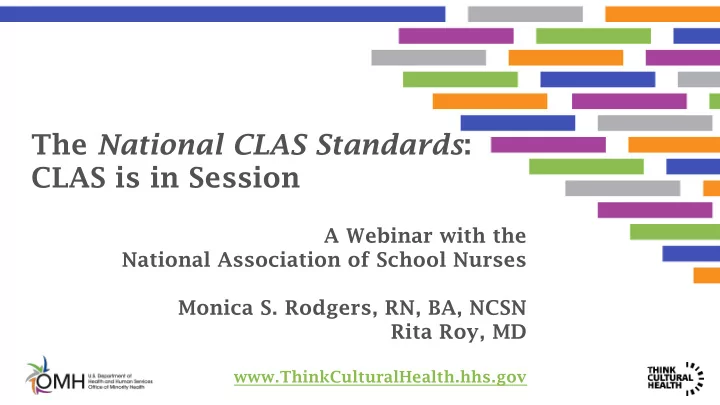

The National CLAS Standards : CLAS is in Session A Webinar with the National Association of School Nurses Monica S. Rodgers, RN, BA, NCSN Rita Roy, MD www.ThinkCulturalHealth.hhs.gov
HHS Office of Minority Health Mission ▸ To improve the health of minority populations through the development of health policies and programs that will help eliminate health disparities.
What are culturally and linguistically appropriate services (CLAS)?
Culturally and Linguistically Appropriate Services (CLAS) Services that are respectful of and responsive to individual cultural health beliefs and practices, preferred languages, health literacy levels, and communication needs and employed by all members of an organization (regardless of size) at every point of contact.
Why does CLAS matter in school nursing?
Why Does CLAS Matter? ▸ Changing demographics ▸ Strengthening relationships ▸ Building trust ▸ Improving communication
CLAS at Every Point of Contact Health Student Family Provider School School Nurse Community
CLAS at Every Point of Contact Health Specialized Health education health care screenings services Acute Care School illness/ planning Nurse injury
What do we mean when we say ‘culture’ and ‘health’?
Culture Race Age Ethnicity Linguistic Characteristics Sex Socioeconomic Status Ability Sexual Orientation Geography Gender Identity Education Environment Spirituality Health Beliefs and Practices
Multiple Cultures Student School Caregiver Nurse
Multiple Identities
Physical Health Social Spiritual Mental
What does good (and bad) communication look like?
Effective Communication Effective communication is a two-way process in which messages are negotiated until both parties correctly understand the information.
Ineffective Communication or Communication Breakdowns Opportunities for communication breakdowns
The confluence of culture, communication, and care
Culture & Communication Culture influences the way an individual communicates verbally and non-verbally
Culture Communication
Areas of Consideration Western versus Primary Language Non-Western Social Food Privilege Customs Social Socioeconomic Determinants Status
How can I put CLAS concepts into practice?
National CLAS Standards 1 PRINCIPAL STANDARD ENGAGEMENT, G OV E R N A N C E , CONTINUOUS L E A D E R S H I P & IMPROVEMENT & WO R K F O R C E ACCOUNTABILITY 2-4 5-8 9-15 C O M M U N I C AT I O N & L A N G U A G E A S S I S TA N C E
Principal Standard ▸ Provide effective, equitable, understandable, and respectful quality care and services that are responsive to diverse cultural health beliefs and practices, preferred languages, health literacy, and other communication needs.
Theme 1 GOVERNANCE LEADERSHIP WORKFORCE
Governance, Leadership, and Workforce ▸ Advance and sustain organizational governance and leadership that promotes CLAS and health equity through policy, practices, and allocated resources. ▸ Recruit, promote, and support a culturally and linguistically diverse governance, leadership, and workforce that are responsive to the population in the service area. ▸ Educate and train governance, leadership, and workforce in culturally and linguistically appropriate policies and practices on an ongoing basis.
Theme 2 COMMUNICATION L A N G U A G E ASSISTANCE
Communication and Language Assistance ▸ Offer language assistance to individuals who have limited English proficiency and/or other communication needs, at no cost to them, to facilitate timely access to all health care and services. ▸ Inform all individuals of the availability of language assistance services clearly and in their preferred language, verbally and in writing. ▸ Ensure the competence of individuals providing language assistance, recognizing that the use of untrained individuals and/or minors as interpreters should be avoided. ▸ Provide easy-to-understand print and multimedia materials and signage in the languages commonly used by the populations in the service area.
Theme 3
Engagement, Continuous Improvement, and Accountability ▸ Establish culturally and linguistically appropriate goals, policies, and management accountability, and infuse them throughout the organization’s planning and operations. ▸ Conduct ongoing assessments of the organization’s CLAS-related activities and integrate CLAS-related measures into measurement and continuous quality improvement activities. ▸ Collect and maintain accurate and reliable demographic data to monitor and evaluate the impact of CLAS on health equity and outcomes and to inform service delivery. ▸ Conduct regular assessments of community health assets and needs and use the results to plan and implement services that respond to the cultural and linguistic diversity of populations in the service area.
Engagement, Continuous Improvement, and Accountability ▸ Partner with the community to design, implement, and evaluate policies, practices, and services to ensure cultural and linguistic appropriateness. ▸ Create conflict and grievance resolution processes that are culturally and linguistically appropriate to identify, prevent, and resolve conflicts or complaints. ▸ Communicate the organization’s progress in implementing and sustaining CLAS to all stakeholders, constituents, and the general public.
How can I put CLAS concepts into practice?
Resource: Think Cultural Health ▸ National CLAS Standards ▸ E-learning programs ▸ Communication Guide Place your screenshot here ▸ Tracking CLAS map ▸ CLAS Library ▸ Quarterly e-newsletter
Resource: National Association of School Nurses Cultural Competency in School Nursing http://nasn.org/toolsresourc es/culturalcompetency Place your screenshot here Questions: nasn@nasn.org
Thank you! Monica S. Rodgers, RN, BA, NCSN Rita Roy, MD www.nasn.org www.ThinkCulturalHealth.hhs.gov AdvancingCLAS@ThinkCulturalHealth.hhs.gov
Recommend
More recommend